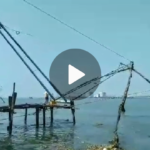“Queen of the Arabian Sea”.

Where is Kochi?
The city of Kochi also known as Cochin. A major city port on the south-west coast bordering the Laccadive Sea in the state of Kerala. Fort Kochi is the city’s tourist area, with the presence of several historical monuments and museums.
This coastal city is a popular tourist hotspot and an active naval base. Officially the home to the Southern Command of the Indian Navy and an air squadron of the Indian Navy. Having its own unique blend of Indian and western culture, whilst still retaining some of its colonial heritage.
Getting there
Our journey from Ooty to Kochi was by local buses.
Our accommodation
Whilst in Kochi, we chose to stay at the Hotel Span International. A very comfortable hotel in the heart of Kochi. Plush beds and fluffy pillows make for a good night’s sleep. Good internet connectivity in the room allowed us to complete the research we needed to carry out.
The restaurant is good. Including a sumptuous breakfast buffet each morning. Also a good selection of evening meals. Take time to relax on the rooftop bar, taking in the views.
Places of interest
Fort Kochi
We took the opportunity to go sightseeing in Kochi, going over to Fort Kochi for the day. From Ernakulam, it was really simple and cheap to get there.
Walking from our accommodation at the Hotel Span International to the Ernakulam boat jetty. A walk of 25 minutes. This is where we got the ferry over to Fort Kochi, a 15 minute trip for 4 Rupees per person. A mode of transport that doesn’t seem to be widely used by international tourists. Fort Kochi is probably the tourist hub for Kochi.

Once there we negotiated a deal with a tuk tuk driver, to take us sightseeing for the day.
We agreed to pay him 100 Rupees for the sightseeing tour and for that we would allow him to take us to 2 shops, for which he would be paid a commission by the shops. This added about 50 minutes to our day and allowed him to boost his wage for the day.
The sightseeing tour took us to:-
Santa Cruz Cathedral
One of the eight Basilicas in Kerala. Counted as one of the heritage edifices, this church is one of the finest and most impressive churches in India.

Originally built by the Portuguese, it was elevated to Cathedral status by Pope Paul IV in 1558. Dutch conquerors who destroyed many Catholic buildings spared it. Later the British demolished the building and João Gomes Ferreira commissioned a new one in 1887. Santa Cruz was proclaimed a Basilica by Pope John Paul II in 1984.
Saint Francis Church
Originally built in 1503, it is one of the oldest European churches in India. Portuguese explorer, Vasco da Gama died in Kochi in 1524 when he was on his third visit to India. His body was originally buried in this church. However, after fourteen years his remains were removed and taken back to Lisbon.

Chinese fishing nets
These have become a popular tourist attraction. The size and elegant construction of the nets provide an ideal photo opportunity. Large mechanical contraptions contain nets of 20m or more across.

Each structure is at least 10 m high. Installation is operated by a team of up to six fishermen. The catch can be purchased and taken to a street food vendor who will cook it for you.
Mattancherry Palace
A Portuguese palace popularly known as the Dutch Palace. It features murals depicting portraits and exhibits of the Rajas of Kochi. Portraits of the Rajas from 1864 onwards are displayed in the Coronation Hall. Its ceiling is decorated with floral wooden designs.
Amongst the other exhibits in the palace are an ivory palanquin, a howdah, royal umbrellas, ceremonial dress used by the royalty, coins, stamps, and drawings.
Dhobi Khana
This community laundry space has existed in the city successfully for many decades.

The origins of the dhobi khana lie in the British colonial period. British officers brought many Tamil villagers to Kochi to work as washermen. This Tamil community became organised in the 1920s, becoming known as the Vannar community.

There are about 40 families currently in the community. Each cubicle with washbowls and water tanks is allotted to one family.

The community offers laundry services to houses, hospitals, hotels, hostels, and government firms.
The clothes are soaked in water and detergent. Harder clothes are washed by beating them on stones. Stains are easily removed by adding a pinch of chlorine. Rinsing the clothes is done twice in freshwater.

The traditional method of starching clothes is by dipping them in rice water is still used.
Drying the clothes is done using a technique of tucking them between the ropes in such a way that they are held securely in place. Though dryers have to be used during the monsoon season. Without them drying the clothes can be a long process, taking them down when it rains and hanging them out again when it stops.

Charcoal irons are used for ironing the clothes.







